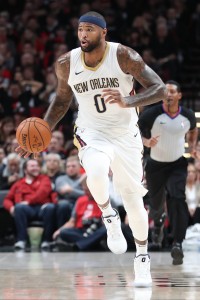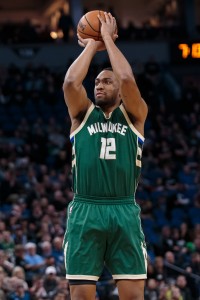Gilbert Arenas hasn’t played in the NBA since 2012, but his legacy lives on in the NBA’s Collective Bargaining Agreement. The NBA introduced the Gilbert Arenas provision in the 2005 CBA as a way to help teams retain their restricted free agents who aren’t coming off standard rookie scale contracts.
While Arenas isn’t specifically named in the CBA, the rule colloquially known as the Arenas provision stems from his own restricted free agency in 2003. At the time, the Warriors only had Early Bird rights on Arenas, who signed an offer sheet with the Wizards starting at about $8.5MM. Because Golden State didn’t have $8.5MM in cap room and could only offer Arenas a first-year salary of about $4.9MM using the Early Bird exception, the Warriors were unable to match the offer sheet and lost Arenas to Washington.
The Arenas provision limits the first-year salary that rival suitors can offer restricted free agents who have only been in the league for one or two years. The starting salary for an offer sheet can’t exceed the amount of the non-taxpayer’s mid-level exception, which allows the player’s original team to use either the mid-level exception or the Early Bird exception to match it. Otherwise, a team without the necessary cap space would be powerless to keep its player, like the Warriors were with Arenas.
An offer sheet from another team can still have an average annual salary that exceeds the non-taxpayer’s mid-level, however. The annual raises are limited to 5% between years one and two, and 4.5% between years three and four, but a team can include a significant raise between the second and third years of the offer.
As long as the first two years of a team’s offer sheet are for the highest salary possible, the offer is fully guaranteed, and there are no incentives included, the third-year salary of the offer sheet can be worth up to what the player’s third-year maximum salary would have been if not for the Arenas restrictions.
Based on a projected $101MM cap for 2018/19, here’s the maximum offer sheet a first- or second-year RFA could receive this coming summer:
| Year |
Salary |
Comment
|
| 2017/18 |
$8,567,770 |
Value of non-taxpayer’s mid-level exception. |
| 2018/19 |
$8,996,159 |
5% raise on first-year salary. |
| 2019/20 |
$27,775,000 |
Maximum third-year salary for a player with 1-2 years in NBA. |
| 2020/21 |
$29,024,875 |
4.5% raise on third-year salary. |
| Total |
$74,363,804 |
Average annual salary of $18,590,951. |
In order to make the sort of offer outlined above, a team must have enough cap room to accommodate the average annual value of the contract. So a team with $19MM in cap space could extend this offer sheet to a first- or second-year RFA. But a team with only $15MM in cap space would have to reduce the third- and fourth-year salaries in its offer sheet to get the overall average salary of the offer down to $15MM per year.
The application of the Arenas provision is infrequent, since first- and second-year players who reach free agency rarely warrant such lucrative contract offers. First-round picks sign four-year rookie deals when they enter the NBA, so the Arenas provision generally applies to second-round picks or undrafted free agents whose first NBA contracts were only for one or two years.
One notable recent example of the Arenas provision at work was Tyler Johnson‘s restricted free agency in 2016. The Heat had Early Bird rights on Johnson, who had only been in the NBA for two seasons. The Nets attempted to pry him away with an aggressive offer sheet that featured salaries of $5,628,000, $5,881,260, $19,245,370, and $19,245,370. It wasn’t the maximum that Brooklyn could have offered Johnson, but the massive third-year raise was a tough pill for Miami to swallow.
Overall, the deal was worth $50MM for four years. If the Heat had declined to match it, the Nets would have flattened out those annual cap hits to $12.5MM per year, the average annual value of the deal. However, due to the Arenas provision, Miami was able to match Brooklyn’s offer sheet with the Early Bird exception, even though the Heat wouldn’t have been able to offer Johnson a four-year, $50MM contract using the Early Bird exception outright.
When a team matches an Arenas-provision offer sheet, it also has the option of flattening those cap charges. However, that option is only available if the team has the cap room necessary to accommodate the average annual value of the deal. Otherwise, the club has to keep the unbalanced cap charges on its books. That’s why Johnson’s cap hit for the Heat will jump from $5,881,260 this season to an eye-popping $19,245,370 in 2018/19.
This coming summer, there aren’t many restricted free agents who will be candidates for an Arenas-provision offer sheet. Top RFAs like Aaron Gordon and Clint Capela have four years of experience, so the rule won’t apply to them. Patrick McCaw looked like a potential Arenas-provision candidate coming into the season, but he has struggled and his value has declined. The best candidate for an Arenas-provision offer sheet may be Raptors guard Fred VanVleet, who has played a key role for Toronto’s excellent second unit. Still, I’d be pretty surprised if VanVleet gets an offer worth more than the standard non-taxpayer’s MLE.
Finally, just because a club is given the opportunity to use the Arenas provision to keep its restricted free agent doesn’t mean it will necessarily have the means. Here are a few situations in which the Arenas provision wouldn’t help a team keep its restricted free agent:
- If the team only had the taxpayer mid-level exception or room exception available, it would be unable to match an offer sheet for a Non-Bird free agent if the starting salary exceeded the taxpayer mid-level or room exception amount.
- A team would be unable to match an offer sheet for a Non-Bird free agent if it used its mid-level exception on another player, including another one of its own Non-Bird free agents. A team could use Early Bird rights to match if those rights are available, however.
- If the player is a Non-Bird or Early Bird free agent with three years of NBA experience, the Arenas provision would not apply — only players with one or two years in the league are eligible.
Note: This is a Hoops Rumors Glossary entry. Our glossary posts will explain specific rules relating to trades, free agency, or other aspects of the NBA’s Collective Bargaining Agreement. Larry Coon’s Salary Cap FAQ was used in the creation of this post.
Earlier versions of this post were published in 2012 and 2015 by Luke Adams and Chuck Myron.

